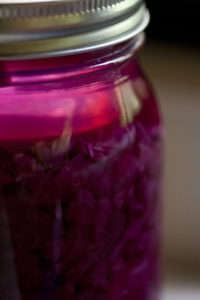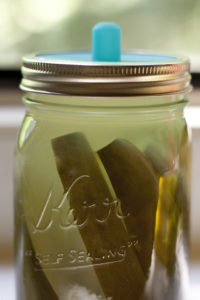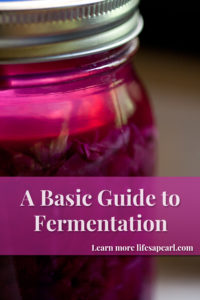What is Fermentation?
Fermentation is one of the oldest and safest forms of food preservation. Fermented foods are present in cultures all across the world. Sandor Ellix Katz writes in his book, The Art of Fermentation, it’s a “natural phenomena that people observed and then learned how to cultivate”. The practice goes back thousands of years, farther than archeologists even know.
Fermentation is basically the process of creating an environment surrounding the food that allows good microorganisms to flourish and keeps pathogens at bay, thereby preserving it and transforming it into something even more nutritious and beneficial.

Different Terms for Fermentation
With several different terms like wild fermentation, lacto-fermentation, and culturing describing this process it can get a little confusing. I found Katz’s explanations in The Art of Fermentation of how these categories break down and overlap to be very helpful in understanding these terms.
Wild fermentation is the process of allowing the microorganisms present in the food or the environment to dictate the fermentation process. It is spontaneous. This could be creating a sourdough starter at home. The wild yeasts in the air are captured to begin the fermentation process.
Lacto-fermentation is a process where lactic acid bacteria dominates the fermentation. Lactic acid bacteria is naturally present in most things. When put in the right environment, it can reproduce and flourish taking over and acting as a natural preservative. As lactic acid bacteria produces it inhibits the growth of pathogens and bacteria that may spoil the food. Making sauerkraut or fermenting pickles in a salt brine are examples of both lacto-fermentation and wild fermentation. Wild fermentation is often the process of lacto-fermentation but not always.
Culturing is the act of adding a microbial starter to an environment to start fermentation. These cultures often contain lactic acid bacteria with a combination of other microorganisms including yeast. An example of this process is using kefir grains or kombucha.
Why Eat Fermented Foods?
In The Art of Fermentation, Katz outlines four practical benefits from fermentation: preservation, health, energy efficiency, and flavor. I started experimenting with fermentation because I was most intrigued with the health benefits.
Fermented food is highly nutritious. The process preserves all the original vitamins found in the food. It often produces additional nutrients and eliminates toxins. Ferments contain active enzymes that assist with digestion.
The fermentation process predigests the food which makes nutrients easy to absorb into our own bodies. Complex carbohydrates are broken down in the fermentation process and converted into organic acids which are easier for our bodies to digest.
Raw food ferments contain live lactic acid bacteria or probiotics. Consuming these supports digestive health and strengthens the immune system. The bacteria takes up residence in our own gut helping our microbiome. In modern times we need to replenish the lactic acid bacteria found in our own bodies and digestive tracts as a result of all the antibacterial chemicals we are exposed to.
It’s best to make your own fermented foods when possible. Finding true fermented foods in the grocery store is difficult. The heat process of making them shelf stable destroys the benefits. Fermented foods should be eaten raw without cooking so you can consume all the beneficial enzymes and probiotics.
How does it work?
While there are many paths to fermenting foods, I use two approaches most often. The first one involves culturing and I’ve been doing it since I realized what fermentation is by making homemade yogurt. I still make my own yogurt. I use both water kefir grains and milk kefir grains to start a fermentation process in sugar water or milk respectively. My ginger bug falls under this category too when I introduce it to sugary ginger water to ferment ginger beer.
With vegetables, I use dry salting or create a salt brine to submerge them in. The salty environment keeps the bad bacteria from growing and allows the good lactic acid bacteria to take over. That preserves the food and makes it even more beneficial to our health. This is the process I use to make sauerkraut, fermented pickles, and fermented jalapenos.
Dry salting is recommended for shredded or small pieces of vegetables as water is released from the vegetable itself in the pounding creating a brine. Making your own brine is recommended for larger or whole pieces of vegetables like long pickle slices or carrots sticks.
In The Art of Fermentation, Katz suggests fermenting vegetables is the ideal way to begin. Fermented vegetables are even safer than raw. Especially given the amount of foodborne illness that has been traced back to tainted produce recently. Pathogens can’t thrive in the fermentation environment and are then destroyed by the lactic acidification.

Which salt and how much to use?
It is important to use unrefined salt when dry salting or creating a brine. Unrefined keeps the minerals available to be digested. You want to avoid salt with added iodine which can have antimicrobial properties that hinders the fermentation. Also avoid anti-caking agents which can cause the vegetables to darken and creates cloudiness.
Read the labels carefully. I read that kosher salt was ok to use but when my husband brought a box home it contained anti-caking agents. I found fine ground pink himalayan salt to be the most unrefined I can get my hands on.
Katz states in The Art of Fermentation, “in most ferments including vegetables, salting can be done to taste”. If measuring salt out he recommends using weight. It’s a better indicator than volume since salts have a variety of grinds and sizes.
My Masontops Fermentation Guide gives a guideline of 1 tbsp fine ground salt per 2 lbs of vegetables for dry salting. For brining, a standard brine is 1 tsp per cup of water. Vegetables with a high water content like cucumbers need a stronger brine so it recommends 1.5 tsp to 2 tsp per cup.
What kind of water?
If you are using water to make a salt brine or sugar water for grains, it is important to use water without high amounts of added chlorine. Chlorine keeps fermentation from happening or sometimes slows and alters it.
If you have chlorinated water, as most tap water is, you can filter it out, boil it uncovered for 20 minutes, or allow it to sit uncovered for at least a day so the chlorine evaporates. If you must boil it, remember to let the water cool back down to room temperature before using. Hot water will kill the microorganisms on the vegetables.
Sunlight
Many online recipes I have come across say to keep your ferments in the dark. While direct sunlight can destroy many microorganisms, Katz writes he doesn’t keep his in the dark but rather in the kitchen and out of direct sunlight.
This was a relief to read for me because I like to keep mine on the kitchen counter but out of direct sunlight. I can keep an eye on my ferments easier and seeing them is a reminder to keep checking on them.

Additional Information
Remember to burp your ferments if you are using a lid with an airtight seal. Vegetable and beverage ferments don’t need oxygen to allow fermentation to occur but they will build up CO2 pressure as they ferment. Airtight jars and bottles can explode if the pressure isn’t periodically released.
When I’m carbonating beverages in a second ferment, I check the pressure once a day if its warm, usually over the sink. With my vegetable ferments, I use a pickle pipe lid so it allows the pressure to escape through a little hole in the top.
It is normal and common for surface molds or yeasts to develop on the edge of your ferment where the liquid meets the air. The growth should be removed but it doesn’t mean your ferment is ruined or that it went bad.
Avoid metal vessels for fermenting since acidic ferments can corrode them and wind up in the food.
Fun fact: Lactic acid bacteria is one of the first bacteria newborn babies are exposed to through childbirth and then continued in breast feeding.
How Long to Ferment?
I have seen several recipes that recommend fermenting for just a few days. I was surprised when my Masontops Guide suggested fermenting sauerkraut for at least a month!
In The Art of Fermentation, Katz suggests tasting the food all along it’s ferment path so you can learn what flavors you best enjoy. Within 2 to 3 days that food will start to transform but it won’t be at its full potential for taste or health benefits. He recommends tasting it at regular intervals from 2 weeks to 2 months if there is still any left.
For people who are concerned about when the ferment is at it’s healthiest in terms of health benefits derived from eating it, he also suggests eating it at different intervals throughout the fermentation process. The food will fluctuate as different types of lactic acid bacteria rise and fall in the environment so that is the best best for consuming diverse bacteria.
If you’re happy with the taste and flavor and wish to stop the fermentation, you can move it to the fridge to slow the fermentation process to an unnoticeable change of pace. Anything below 55° F will in essence stop the fermentation process. Fermented food can last for years at this temp and below.
My Fermenting Journey
Fermentation is becoming a lost art. Leaving food out on the counter at room temperature seems scary to those of us who have grown up with refrigeration. We associate bacteria with the bad types as something to get rid of rather than something necessary to nourish our bodies and keep us in good health.
Not only is it important to understand and pass on this process in a time that doesn’t really value it, it can give you confidence to explore and experiment with food in your kitchen. It’s safe, inexpensive, easy to get started, and the creative combinations are endless.
So far, I have made a ginger bug and several batches of ginger beer. I’ve kept milk kefir, water kefir, and yogurt going continuously. For vegetables, I have fermented sauerkraut, pickles, jalapeños, and carrot sticks. I’m enjoying mixing in different spices as well as observing how the flavors change the longer the ferment.

Fermentation Resources:
The Art of Fermentation by Sandor Ellix Katz
Masontops – for weights and pickle pipe lids (not necessary but I found them helpful)
Cultures for Health – I got my kefir grains here. They sell yogurt starters and kombucha starters as well and have a blog with great information
What fermented foods have you tried?


